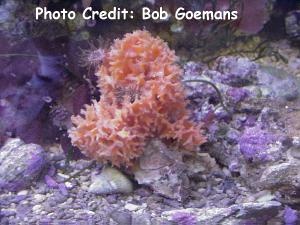
By Bob Goemans


Likely Reef Tank Suitable
Likely Fish-Only Tank Suitable
These appear in the trade mostly on purpose and having some value in our aquariums.
FYI - Sponges posses no nervous, digestive or excretory systems, and feed by filtering suspended bacteria and fine detritus. Strong water movement is vital to almost all, not only for carrying food to these sessile creatures but also to carry waste/unused matter away. In fact, a sponge the size of a baseball can filter fifty gallons of water per hour! Most do best only in low light areas and where currents are quite swift.
Each sponge has both female and male reproduction capabilities. Cutting a piece from the healthy tissue and simply relocating it to another area can form new colonies. Bear in mind the new specimen should not be exposed to air during the procedure as that may kill it. New purchases should be bagged under water with no oxygen added or should the bag contain an air space while being transported. They are not too sensitive to temperature changes, yet sudden changes in salinity may have drastic effects.
New specimens should not contain any gray or white tissue, which is generally a sign of dying or dead tissue. However, it is possible to cut that section out, of course under water. Sponges should be placed in shaded areas where water movement is very good and detritus or algae do not accumulate on their surface. They feed upon plankton and suspended detritus, and require numerous feedings per day of live and/or preserved commercial phytoplankton products or that of animal and plant powders that produce suspended products in the bulk water.
Without a doubt, most sponges should remain in the wild, as they are difficult to impossible to maintain in captivity, and/or simply not suited for confinement in closed systems.
As water motion is important for home aquarium sponges, I've decided to relate it to the visible intensity of water motion on that of a long tentacle anemone. No visible tentacle motion is '0,' whereas a slight movement of some tentacles is '1.' If all the tentacles are gently swaying in the current it is '2.' If all tentacles are moving fairly fast and bouncing into each other it is '3.' Should all tentacles be driven with such force they are extended in one direction or unable to sway back to their central position it's '4.'
You will see as WM - X. Hopefully you'll find this quite helpful.